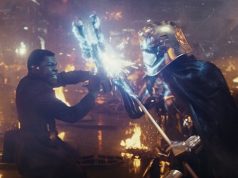The surprisingly robust prequel “Rise of the Planet of the Apes” ended with a few dozen chimps, gorillas, and such escaping into the forests near San Francisco after being dosed with a drug that made them super intelligent (for apes). Over time, these animals will evolve into the Statue of Liberty-destroying, Heston-bedeviling dominant species we know from the “Planet of the Apes” movies of the ’60s and ’70s. But as “Dawn of the Planet of the Apes” picks up the story, 10 years after “Rise,” humans are still technically in charge, and the apes are still learning what they themselves are capable of.
Directed with serious intensity by Matt Reeves (“Cloverfield,” “Let Me In”), “DOTPOTA” offers parallel societies, one crumbling and one rising (or dawning). The drug that made the monkeys smart was also a pathogen that wiped out millions of humans, leaving pockets of survivors here and there to rebuild. One such group lives in what’s left of San Francisco, led by the bellicose Dreyfus (Gary Oldman) and the more level-headed Malcolm (Jason Clarke). Out in the forest, meanwhile, under the direction of wise Caesar (Andy Serkis in a motion-capture suit), the apes live peaceably, communicating in sign language and rudimentary speech, using spears to capture prey, teaching their offspring the laws of their society (“Ape not kill ape”).
The two groups clash when the humans need to pass through ape-controlled territory to access a hydroelectric dam and restore power to their city. Malcolm, his girlfriend Ellie (Keri Russell), and his teenage son Alexander (Kodi Smit-McPhee), are all cool with the apes, befriending Caesar and Maurice (Karin Konoval), his orangutan consigliere. But bonobo Koba (Toby Kebbell), having no experience with humans except for being tortured and experimented upon by them, hates ’em all, wants to kill ’em. Koba’s counterpart among the humans isn’t Dreyfus — he doesn’t hate apes, just doesn’t care whether they live or die — but a man named Carver (Kirk Acevedo), who blames the apes for society’s downfall and hates every ape he sees, from chimpan-A to chimpan-Z.
“Rise of the Planet of the Apes” (2011) B+
“Dawn of the Planet of the Apes” (2014) B
“War for the Planet of the Apes” (2017) B+
Well, the situation’s a big ol’ powder keg, just waiting for something to spark, and one of the film’s many pleasures is the tension of knowing something is bound to happen while hoping it won’t. As is often the case in these scenarios, all it takes to ignite a skirmish is one trigger-happy idiot with a grudge. Dreyfus assures his people that they can beat the apes through weaponry: “This city may not have the manpower it once did, but it has the firepower.” The apes, of course, do not have guns. Yet.
I wouldn’t go so far as to say that the film (which was written by “Rise” duo Rick Jaffa and Amanda Silver, plus Mark Bomback) is anti-gun, but it does underscore the indisputable historical fact that the body count always goes up when spears and arrows are replaced by rifles and pistols. As the tragedy of war threatens to take over the story, bittersweet yet entertaining in its blockbuster sensibilities, it’s hard not to think of the European settlers and the Indians. The twist here is that we know the apes are eventually going to win … except that “winning” in this case means becoming just like humans, which is a mixed bag. (Pro: schools and libraries. Con: wanton murder.) Soulful performances by the actors behind the digital animals help the film overcome the limitations inherent in being a story about super-smart monkeys. You’re liable to forget that very little of what you see on the screen actually exists, so cleverly has Reeves’ team of tech wizards rendered it.
B (2 hrs., 10 min.; )





